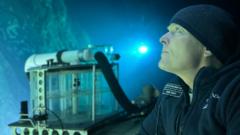Was Oceangate's Titan a Deception? A Whistleblower Speaks Out

The Tragic Disappearance of Titan: A Cautionary Tale of Safety and Oversight
In June 2023, the world was captivated and horrified by the news of the Titan submersible's disappearance during a dive to the iconic wreck of the Titanic. The tragic implosion claimed the lives of all five individuals aboard, including Stockton Rush, the CEO of Oceangate. This incident has raised significant questions about safety practices, regulatory oversight, and accountability in marine exploration. David Lochridge, a former director at Oceangate, had raised alarms about the very safety issues that ultimately contributed to this catastrophe. His story highlights the critical importance of whistleblower protections and the role of regulatory bodies in preventing avoidable disasters.
The Whistleblower's Perspective
David Lochridge had dedicated over 25 years to marine operations, having first served in the Royal Navy and later as a submersible pilot. He joined Oceangate with enthusiasm, eager to contribute to the ambitious project of developing a submersible capable of transporting paying passengers to the depths of the Titanic wreck. However, his initial excitement soon turned to concern as he began to identify serious safety issues with the Titan submersible’s design and construction.
Concerns Over Design and Safety
Oceangate's decision to use carbon fiber for the hull of Titan was unprecedented, as most deep-diving submersibles traditionally rely on materials like titanium or steel. Despite initial confidence in the partnership with the University of Washington's Applied Physics Laboratory (APL), Lochridge grew uneasy when Oceangate shifted the design and construction in-house. His apprehension was rooted in the lack of experience he perceived among the in-house engineers regarding the immense pressures at depths typical of the Titanic’s location.
As parts for Titan began to arrive, Lochridge reported seeing numerous defects. Visible gaps in the carbon fiber, improper machining of titanium components, and concerns regarding the viewport's design compounded his worries. Most alarmingly, he discovered that Titan would not undergo independent safety certification—something he deemed essential given the experimental nature of its materials.
Raising the Alarm
Despite his growing concerns, Lochridge felt a strong sense of duty to voice his observations. He formally reported these issues to his superiors, but was met with resistance. In January 2018, he escalated his safety concerns directly to Stockton Rush. During a critical meeting, Lochridge presented an inspection report detailing his findings, yet his warnings fell on deaf ears. Rush’s dismissive response, emphasizing his personal safety and confidence in the project's safety, only deepened Lochridge's fears.
The Fallout of Whistleblowing
Lochridge's commitment to safety ultimately cost him his job. Shortly after the meeting, he was dismissed from Oceangate. Undeterred, he sought assistance from the Occupational Safety and Health Administration (OSHA), which classified his complaint as urgent due to public safety implications. Unfortunately, the response from OSHA proved slow and inadequate, leading to further frustrations for Lochridge.
The Legal Struggle
After filing his complaint with OSHA, Lochridge faced a legal backlash from Oceangate. The company filed a lawsuit against him, alleging various claims, including breach of contract and misappropriation of trade secrets. Lochridge countered with a claim for wrongful termination. Despite his efforts, the legal battle drained Lochridge and his family, leading them to ultimately drop their case against Oceangate.
Continuing the Mission
Despite the controversies surrounding its safety practices, Oceangate moved forward with the Titan project. The submersible conducted test dives, including one that reached a depth of 3,939 meters, only to later reveal a crack in the carbon fiber hull. A replacement hull was subsequently constructed, allowing the company to resume its dives to the Titanic wreck in 2021.
The Final Dive
In June 2023, the Titan submersible embarked on what would be its final dive, carrying five individuals excited to witness the Titanic’s remains. Unfortunately, the vessel suffered a catastrophic implosion, leading to the deaths of all aboard. The wreckage was later found scattered across the ocean floor, a grim reminder of the perils of deep-sea exploration.
Investigations and Findings
In the wake of the disaster, the US Coast Guard conducted an investigation that underscored the failures within Oceangate’s safety protocols. Their report highlighted deficiencies in safety, testing, and maintenance practices as primary contributors to the incident. Lochridge reiterated his belief that had the concerns he raised been taken seriously, the tragedy could have been avoided.
The Role of Regulatory Bodies
The aftermath of the Titan disaster has sparked a significant dialogue about the role of regulatory agencies like OSHA and the US Coast Guard in ensuring public safety in marine operations. Lochridge criticized OSHA for its slow response, arguing that a more proactive approach could have led to preventative measures that might have saved lives. The Coast Guard's report also acknowledged that the communication between OSHA and the USCG fell short, emphasizing the need for improved coordination in future investigations.
Calls for Reform
In light of the findings, there are growing calls for reform within regulatory frameworks governing marine exploration. Enhancing whistleblower protections and ensuring rigorous safety assessments for experimental technologies can help mitigate risks in high-stakes environments like deep-sea exploration. The Titan incident serves as a cautionary tale, reminding stakeholders of the dire consequences that can result from overlooking safety protocols.
Conclusion: Lessons Learned
The tragic story of the Titan submersible is not merely a tale of loss but a stark reminder of the importance of safety, accountability, and transparency in marine operations. David Lochridge's experience highlights the essential role of whistleblowers in safeguarding public safety and the need for regulatory bodies to act decisively on safety concerns. As the marine exploration industry continues to evolve, it is imperative that lessons from this incident are learned, paving the way for safer practices in the future.
FAQs
What happened to the Titan submersible?
The Titan submersible imploded during a dive to the Titanic wreck in June 2023, resulting in the deaths of all five people aboard, including Oceangate CEO Stockton Rush.
Who was David Lochridge?
David Lochridge was the former Director of Marine Operations at Oceangate. He raised safety concerns about the Titan submersible before it was put into operation and faced retaliation for his whistleblowing.
What were the primary causes of the Titan disaster?
The US Coast Guard's investigation identified safety failures in design, testing, and maintenance as the main causes of the Titan disaster.
What actions have been taken since the Titan incident?
In response to the Titan disaster, there have been calls for reform in regulatory practices, particularly regarding whistleblower protections and safety assessments for experimental technologies in marine exploration.
As we reflect on the Titan tragedy, we must consider the implications for future marine exploration. How can we ensure that safety is prioritized in high-risk industries? #TitanSubmersible #SafetyFirst #MarineExploration
Published: 2025-08-06 05:49:08 | Category: technology



